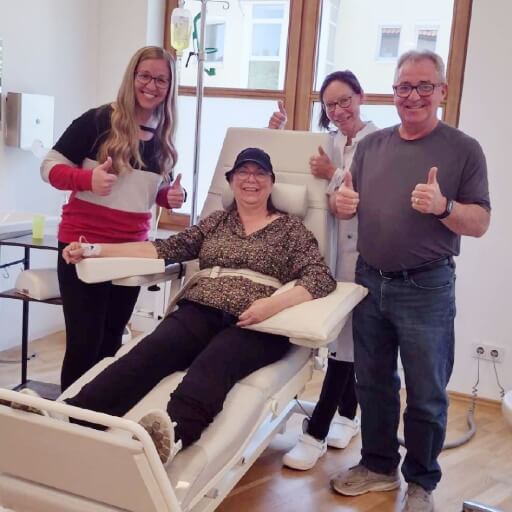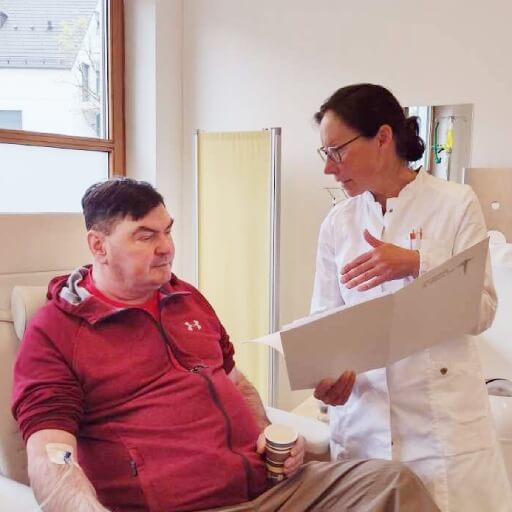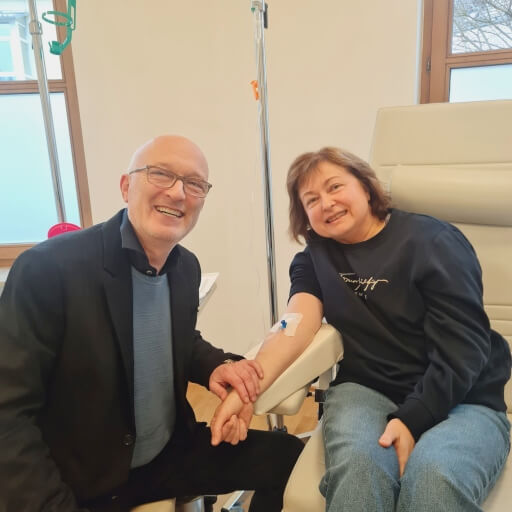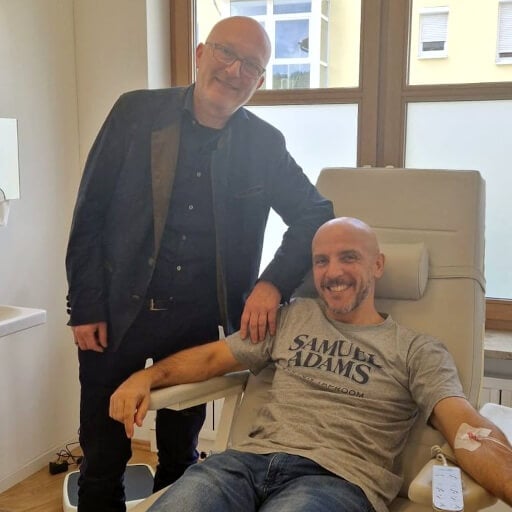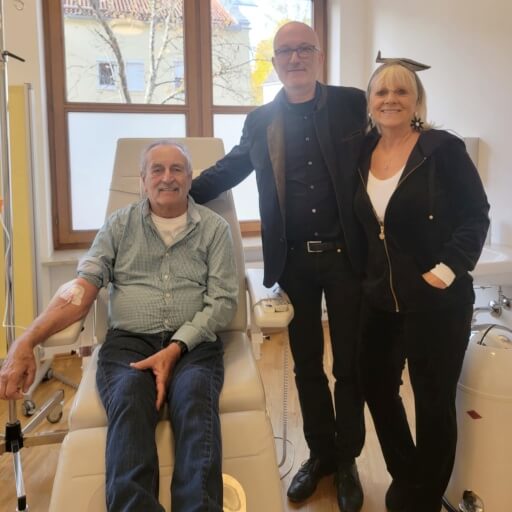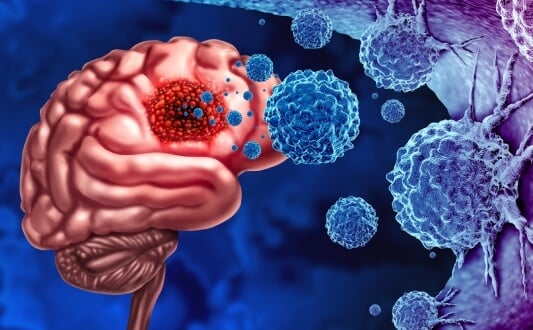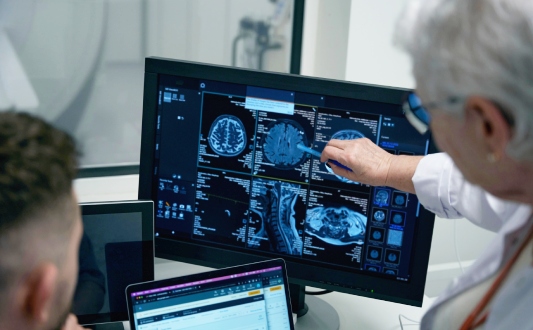الورم الدبقي Glioma هو نوع من أورام الدماغ الأولية التي تتطور من الخلايا الدبقية في الدماغ والحبل الشوكي. يُشكل الورم الدبقي أكثر من 24٪ من جميع أورام الدماغ الأولية، وحوالي 50-70٪ منها أورام خبيثة. يمكن أن يؤثر الورم الدبقي على كل من المرضى البالغين والأطفال على حدٍ سواء، حيث يعاني منه البالغون فوق سن 65 عاماً والأطفال دون سن 12 عاماً بشكل أكثر تكراراً من الفئات العمرية الأخرى. اعتماداً على نوع الخلايا التي ينشأ منها الورم، هناك ثلاثة أنواع رئيسية من الورم الدبقي: الورم النجمي، والورم الدبقي قليل التغصن، والورم الأرومي الدبقي. بناءً على مدى تمايز الورم، يمكن تصنيفه إلى أورام منخفضة الدرجة (حميدة عادةً) وعالية الدرجة (خبيثة).
بصرف النظر عن كونها النوع الأكثر انتشاراً من أورام الدماغ الأولية، فإن الأورام الدبقية تُشكل تحدياً كبيراً للإدارة. تختلف معدلات البقاء على قيد الحياة أيضاً بشكلٍ كبير اعتماداً على موقع الورم، وتمايزه، وعمر المريض. يمكن أن تمنح الأورام الدبقية منخفضة الدرجة في بعض الأحيان ما يصل إلى 90٪ من فرص البقاء على قيد الحياة لمدة 5 سنوات. ومع ذلك، نادراً ما يتجاوز معدل البقاء على قيد الحياة لدى المرضى المصابين بالورم الأرومي الدبقي 10٪، في حين أن الأورام الدبقية في جذع الدماغ، مثل الورم الدبقي الجسري الداخلي المنتشر، لا تضمن البقاء على قيد الحياة حتى لمدة عامين للأطفال بعد تأكيد التشخيص. نظراً للطبيعة المعقدة والمتشابكة لهذه الأورام الخبيثة، هناك حاجة مُلحة لعلاجات جديدة للورم الدبقي من أجل منح فرص أفضل للبقاء على قيد الحياة.
خيارات العلاج القياسية للورم الدبقي
تعتمد استراتيجية علاج الورم الدبقي على عدد من العوامل:
- نوع الورم
- موقع الورم
- حجم الورم
- صحة المريض
- العمر
- تاريخ مع سرطان الدماغ، ونوع العلاج المُطبق، وفعاليته
تُعتبر الجراحة، والعلاج الإشعاعي، والعلاج الكيميائي أساس علاج سرطان الورم الدبقي لجميع أنواعه. مع ذلك، قد تختلف استجابة العلاج اعتماداً على نوع الورم (الورم النجمي، والورم الدبقي قليل التغصن، والورم الأرومي الدبقي) وموقعه. يُعد عمر المريض، وطفرة IDH (نازعة هيدروجين الايزوسيترات)، وحذف الجين 1p/19q من بين العوامل الرئيسية الأخرى التي تؤثر على كلاً من البقاء على قيد الحياة واستراتيجية الإدارة.
الجراحة تُعتبر بمثابة النقطة المركزية في المبادئ التوجيهية لعلاج الورم الدبقي، بغض النظر عن نوع الورم. الهدف من الجراحة هو إزالة أكبر قدر ممكن من أنسجة الورم. يتم تطبيق أنظمة توجيه مختلفة لتوفير الاستئصال الدقيق والحفاظ على الخلايا العصبية المتبقية. تتضمن أدوات التنقل المبتكرة هذه ما يلي:
- التصوير بالرنين المغناطيسي الوظيفي
- تصوير موتر الانتشار
- التصوير بالرنين المغناطيسي MRI أثناء العملية
- المراقبة الوظيفية (لتجنب العجز العصبي اللاحق الناجم عن الجراحة)
- تصور الورم بالفلورسنت
يُنصح باستخدام تخطيط الدماغ، والجهد المُستحث، وتخطيط كهربية العضل لدى المرضى في حالة اليقظة تحت التخدير الموضعي للحفاظ على الوظائف المعرفية والمهارات اللغوية بعد الاستئصال.
العلاج الإشعاعي يُعد جزءاً أساسياً آخر من علاج الورم الدبقي القياسي. عادةً ما يتبع الجراحة، ويهدف إلى القضاء على أي خلايا خبيثة متبقية بعد التدخل الجراحي. ثبُتَ أن العلاج الإشعاعي بعد الجراحة يُزيد من معدل البقاء على قيد الحياة، ويُحسن السيطرة على المرض بشكلٍ عام، ويمنع التدهور العصبي المبكر. يتم تحديد التوقيت الدقيق، والجرعة، ومدة العلاج حسب خصائص الورم، وحجم الخلايا الخبيثة المتبقية، وعمر المريض. يُعد العلاج بالبروتون مفيداً بشكلٍ خاص لكبار السن أو المرضى الضعفاء نظراً لدقته العالية. يستهدف هذا العلاج الخلايا الخبيثة بجزيئات صغيرة مشحونة. كما يفضل العلاج بالبروتون لعلاج سرطانات الورم الدبقي العدوانية والأورام المتكررة بعد العلاج السابق واسع النطاق باستخدام العلاج الإشعاعي والعلاج الكيميائي.
العلاج الكيميائي للورم الدبقي يُعد جزءاً من الاستراتيجية العلاجية لإدارة الورم الدبقي. يتم إعطاؤه عادةً بعد العملية، على الرغم من أن المؤشرات المحددة تختلف اعتماداً على نوع ودرجة الورم. على سبيل المثال، لا يؤخذ هذا الأمر بعين الاعتبار بشكلٍ عام للدرجة الثانية من الأورام النجمية والورم الدبقي قليل التغصن إلا إذا لم يتم تحمل العلاج الإشعاعي. أدت إضافة العلاج الكيميائي إلى خطة علاج الدرجة الثالثة من الورم الدبقي قليل التغصن إلى تحسين معدلات البقاء على قيد الحياة. ومع ذلك، بالنسبة للورم النجمي من الدرجة الثالثة والرابعة، ثَبُتَ فعاليته فقط كعلاج كيميائي مساعد. العوامل المؤلكلة هي الأدوية الكيميائية العلاجية الرئيسية المُستخدمة في العلاج.
العلاجات المبتكرة
إيجاد علاج جديد للورم الدبقي يعتبر أمراً ضرورياً لأن العديد من الأورام تُظهر تكراراً متكرراً. علاوةً على ذلك، تُشكّل مقاومة العلاج الإشعاعي والعلاج الكيميائي، بالإضافة إلى الاختلالات العصبية الناتجة عن العلاج، تحديات كبيرة لأطباء الأورام، وتُمهّد الطريق لعلاجات مبتكرة. تُعد الأشعة التداخلية والعلاج المناعي، وخاصةً لقاحات الخلايا المتغصنة، في طليعة خيارات العلاج المتقدمة.
الأشعة التداخلية
تلعب الآن الإجراءات الموجهة بالصور طفيفة التوغل، مثل العلاج الكيميائي الكهربائي واجتثاث الورم عبر الجلد، دوراً متزايد الأهمية في علاج الورم الدبقي المتكرر والمتقدم. من خلال استخدام تقنيات التصوير في الوقت الحقيقي، مثل التصوير بالموجات فوق الصوتية والتصوير المقطعي المحوسب، تسمح هذه التدخلات بتوصيل العلاج بدقة إلى بؤر الورم مع تعزيز الدقة وتقليل الضرر للأنسجة المحيطة. ومع ذلك، تختلف حساسية وفعالية هذه التقنيات اعتماداً على نوع الورم.
*بيانات البروفيسور الدكتور في الطب أتيلا كوفاتش
الاجتثاث الحراري، وتحديداً العلاج الحراري الخلالي بالليزر، هو تقنية اجتثاث يتم فيها تحويل الليزر إلى طاقة حرارية، والتي يمكنها تدمير الخلايا السرطانية. يُعد LITT الموجه بالتصوير بالرنين المغناطيسي طريقة معتمدة من قبل إدارة الغذاء والدواء الأمريكية FDA لاجتثاث الأنسجة العصبية المرضية، بما في ذلك علاج الورم الدبقي في جذع الدماغ، والأورام الدبقية في مواقع أخرى، والورم الأرومي الدبقي. يرتبط LITT بزيادة معدلات البقاء على قيد الحياة وتوقف التقدُم.
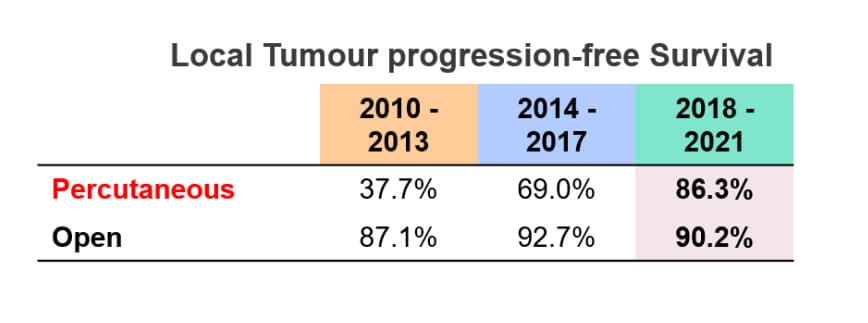
*بيانات البروفيسور الدكتور في الطب أتيلا كوفاتش
أظهرت الدراسات تحسُناً في معدلات البقاء على قيد الحياة بشكلٍ عام بعد إعطاء LITT بعد العلاج الإشعاعي القياسي، مع متوسط بقاء على قيد الحياة بشكلٍ عام لمدة 16.14 شهراً، على العكس 9 أشهر بعد رعاية الورم الدبقي القياسي وحده. علاوةً على ذلك، يُعدّ LITT خياراً مفضلاً للمواقع التي يصعب الوصول إليها.
الاجتثاث بالترددات الراديوية (RFA) هو طريقة طفيفة التوغل تُستخدم لاستئصال الأورام عن طريق رفع درجات الحرارة الناتجة عن ترددات راديوية محددة. نتيجةً لذلك، يُسبب نقص التأكسج في الأنسجة وارتشاح الموقع مع الخلايا المناعية، مما يساعد على استئصال الورم. يُعد الاجتثاث بالترددات الراديوية إجراءً متاحاً على نطاق واسع، مما يضمن تحسين السيطرة الموضعية على الورم ويُزيد من معدلات البقاء على قيد الحياة دون تقدُم والبقاء على قيد الحياة بشكلٍ عام، خاصةً إذا تم دمجه مع العلاج الجهازي، كما هو موضح في الرسم البياني أدناه.
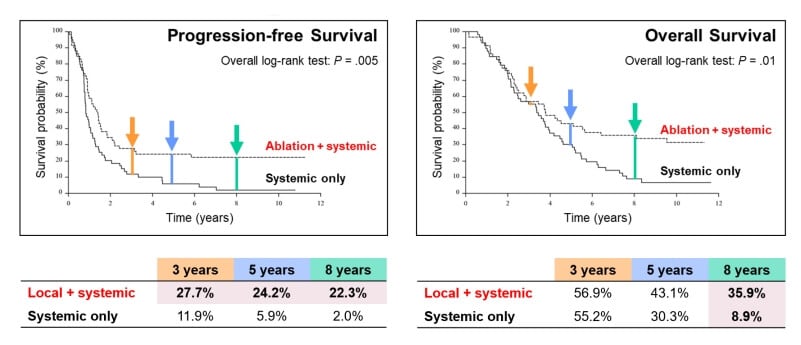
*بيانات البروفيسور الدكتور في الطب أتيلا كوفاتش
بالإضافة إلى ذلك، قد يمنع الانتكاس الإضافي عن طريق تحفيز الاستجابة المناعية الخاصة بالورم في موقع الورم. قد يكون هذا سبباً في أن يكون RFA جزءاً من الرعاية القياسية لـ الورم النجمي من الدرجة الرابعة بعد الجراحة.
العلاج الكيميائي الكهربائي (ECT) هو تقنية تستخدم التثقيب الكهربائي غير المعكوس لتعزيز حساسية الورم الدبقي للعوامل العلاجية الكيميائية. يُعد هذا العلاج مفيداً بشكلٍ خاص لعلاج الورم الدبقي، الذي يتمتع بموقع صعب أو يُظهر استجابة ضعيفة للعلاج الكيميائي. يؤدي توصيل ECT داخل الورم إلى تراجع حجم الورم. تُظهر الأبحاث أن هذا التراجع يمكن أن يصل إلى 65٪. كما أنه يُقلل من خطر تكرار المرض ويُحسن معدلات البقاء على قيد الحياة. ومع ذلك، يعتمد هذا الأخير على طريقة إعطاء العلاج الكيميائي، والذي يكون أعلى عند إعطاءه داخل الشرايين.
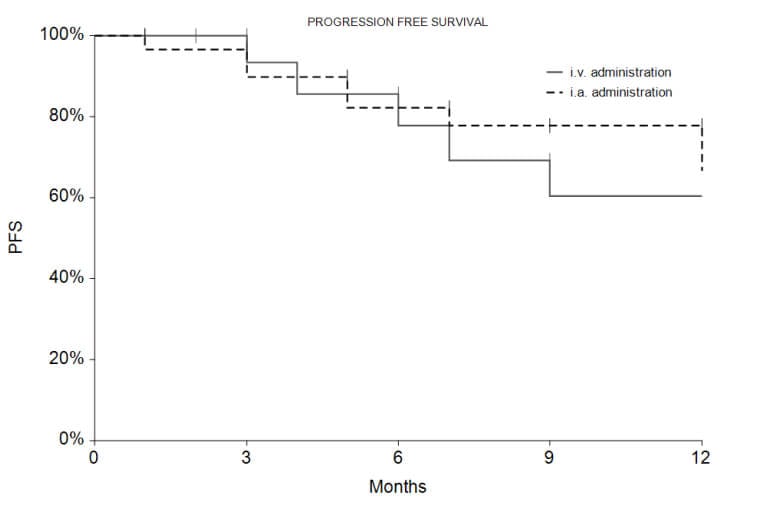
*بيانات البروفيسور الدكتور في الطب أتيلا كوفاتش
الاجتثاث بالتبريد هو تدخل جراحي يركز على التجميد لإزالة أنسجة الورم. يُستخدم هذا العلاج بشكل نشط لعلاج الورم الميلانيني (الميلانوما) وأورام الكلى. مع ذلك، فإن مجموعة متزايدة من الأبحاث تُظهر الآن فعاليته في علاج آفات الورم الدبقي الكبيرة، والأورام المتكررة، والأورام في المواقع الصعبة (على سبيل المثال، سرطان جذع الدماغ الدبقي). أفادت التقارير أن الاجتثاث بالتبريد يُزيد من معدلات البقاء على قيد الحياة الخالي من تقدُم المرض، حتى بالنسبة للأورام عالية الدرجة مثل الورم الأرومي الدبقي، حيث تُشير بعض التقارير إلى زيادة بنسبة 50٪. بالإضافة إلى ذلك، فهو تدخل آمن وجيد التحمل، ويمكن إعطاؤه للمرضى المُنهكين من وسائل أخرى.
العلاج بالخلايا المتغصنة
العلاج بالخلايا المتغضنة Dendritic Cell Therapy هو تقنية علاج مناعي فريدة من نوعها، تعمل على تنشيط جهاز المناعة لدى المريض لمكافحة السرطان. الخلايا المتغصنة هي بمثابة "كشافة" جهاز المناعة. تُقدم عوامل غير معروفة إلى جهاز المناعة، وتُحفِّز الاستجابة المناعية. مُنح رالف ستاينمان، مكتشف الخلايا المتغصنة، جائزة نوبل عام 2011 تقديراً لهذا الابتكار الرائد. عندما يتعلق الأمر بإدارة السرطان، تكون الخلايا المتغصنة فعالة في اكتشاف الخلايا الخبيثة التي تحاول باستمرار التهرب من الاستجابة المناعية وخلق بيئة مكروية مُثبطة للمناعة. وبذلك، تقوم الخلايا المتغصنة بإبلاغ بقية الجهاز المناعي وتوجيهه إلى بؤر الورم للإزالة الموجهة لاحقاً.
يرتبط التطعيم بالخلايا المتغصنة بتحسُن معدلات البقاء على قيد الحياة بين مرضى الورم الدبقي. أظهرت العديد من التجارب العشوائية المُتحكم بها أن إعطاء لقاح الخلايا المتغصنة (DCV) أدى إلى زيادة متوسط معدلات البقاء على قيد الحياة بشكلِ عام (31.9 في مجموعة DCV مقابل 15 شهراً في المجموعة المُتحكم بها). بصرف النظر عن ذلك، أفاد الأطباء أن مرضى الورم الأرومي الدبقي الذين تم تشخيص إصابتهم حديثاً لديهم استجابة أفضل للعلاج. كما أن معدلات البقاء على قيد الحياة على المدى الطويل لسرطان الدماغ (الورم الدبقي الخبيث) قد تتحسن بشكل ملحوظ بعد إعطاء DCV وتصل إلى 36٪.
لا تزال المحادثات مستمرة حول متى يتم إعطاء لقاح الخلايا المتغصنة. تخضع معظم الأورام الدبقية السرطانية للعلاج بالخلايا المتغصنة بعد الجراحة. يساعد هذا على استئصال كتلة الورم، التي تُظهر خصائص كابتة للمناعة، ويُحسّن التعرف المناعي عليها. لذلك، يُعدّ القضاء اللاحق على الورم باستخدام العلاج بالخلايا المتغصنة أكثر فعالية، مما يؤدي إلى تحسين السيطرة الموضعية على المرض وتحقيق نتائج أفضل.
| خصائص/نوع العلاج | معدل البقاء على قيد الحياة لمدة عامين | معدل الاستجابة | المدة | الآثار الجانبية |
|---|---|---|---|---|
| العلاج القياسي | ~٪25 للسرطان المتقدم | أقل من 10٪ | عدة دورات | شديدة (غثيان، وتعب، وتساقط الشعر، وكبت المناعة، وتهيُج الجلد) |
| الأساليب المبتكرة | ~٪60 للسرطان المتقدم | ٪65-45 | ما يصل إلى 4 جلسات | خفيفة (شعور موضعي بعدم الارتياح) |
* بيانات Booking Health
مقارنة لتكاليف العلاجات القياسية مقابل العلاجات المبتكرة
| طريقة العلاج | ألمانيا* | بريطانيا العظمى | الولايات المتحدة الأمريكية |
|---|---|---|---|
| العلاج القياسي | 80.000 € - 150.000 € دورة كاملة | 90.000 € - 165.000 € دورة كاملة | 100.000 € - 180.000 € دورة كاملة |
| الأساليب المبتكرة | 25.000 € - 60.000 € دورة كاملة | 70.000 € - 120.000 € دورة كاملة | 100.000 € - 150.000 € دورة كاملة |
* قد تختلف الأسعار اعتماداً على دورة العلاج وخصائص الورم
أمل جديد مع العلاج المبتكر: نجاح مرضانا
يُعد تشخيص ورم الدماغ، بما في ذلك سرطان الورم الدبقي، أمراً صادماً للكثير من الناس. قد لا تكون الأعراض محددة، في حين أن التقدُم يكون سريعاً عادةً. لذلك، ينبغي التحرك بسرعة والسعي بنشاط للحصول على العلاجات المتاحة. كانت هذه بالضبط حالة داريا روجرز من أيرلندا. بعد تشخيص إصابة داريا بالورم الدبقي متعدد الأشكال من الدرجة الرابعة، قامت هي وزوجها بدراسة العديد من التقارير العصبية، بحثاً عن أفضل إدارة بعيداً عن الجراحة. في هذه اللحظة تحديداً، عثر الزوجان على العلاج بالخلايا المتغصنة.
تفاجأت داريا وزوجها بسرور من بساطة الإجراء بعد السفر إلى ألمانيا، التي هي في الأساس خارج البلاد. "كانت مجرد زيارة للمستشفى وسحب عينة دم. أُرسلت العينة إلى المختبر،" يقول زوج داريا، موريس. كان غياب الآثار الجانبية مفاجئاً أيضاً. "لم تكن هناك أي آثار جانبية أو مشاكل كبيرة كان علينا التعامل معها،" تُعلق داريا قائلة. بعد مرور 3 أشهر على دورة العلاج، لم يتم العثور على أي علامات لبؤر الورم في التصوير بالرنين المغناطيسي MRI. "كانت نتائج الفحوصات واضحة تماماً،" يتذكر موريس. لم يصدق الزوجان الأمر، لذا قاما بإعادة الفحص وحصلا على نفس النتائج.
بخلاف ذلك، لاحظت داريا وزوجها التأثيرات المضادة للشيخوخة للعلاج بالخلايا المتغصنة. "أبدو أكثر نضارة وشباباً،" قالت داريا. بالإضافة إلى ذلك، فإن داريا مقتنعة بأن العلاج بالخلايا المتغصنة مكنها من تحمل العلاج الكيميائي الإشعاعي. حتى أثناء خضوعها للعلاج الكيميائي والعلاج الإشعاعي، بدت "متألقة بشكل لافت" كما يتذكر زوجها. تعتقد داريا أنهم تمكنوا من استقرار المرض والمرور ببروتوكول العلاج القياسي المُرهق بسبب الطبيعة الاستثنائية لهذا النهج.
تؤكد داريا وموريس أن العلاج في الوقت المناسب يُعد أمراً حيوياً. "تحتاج للبدء مبكراً، بسرعة،" يُلخّص موريس الأمر. يؤدي بدء علاج مبكراً إلى تحسين فرص البقاء على قيد الحياة بشكلٍ كبير، والعلاجات المبتكرة مثل العلاج بالخلايا المتغصنة تساعد في المكافحة لاستعادة حياتك مرة أخرى.
من أيرلندا إلى ألمانيا: معركة داريا روجرز الناجحة ضد الورم الأرومي الدبقي من الدرجة الرابعة
ليس حكماً: إدارة المراحل المتقدمة من الورم الدبقي
قد يبدو سماع عبارة "المرحلة الرابعة من السرطان" بمثابة الوصول إلى طريق مسدود، وهي نقطة تبدو فيها خيارات العلاج محدودة ويبدو الأمل وكأنه يتلاشى. يحاول أفراد العائلة والأصدقاء تقديم الراحة، في حين يقترح فريق من أخصائيي أورام الدماغ علاجاً قد لا يؤثر إلا بشكل طفيف على جودة الحياة الضعيفة بالفعل. لكن ماذا لو لم تكن هذه نهاية القصة؟ ماذا لو كانت هناك إمكانيات وطرق حقيقية لإدارة الورم الدبقي عالي الدرجة بفعالية أكبر دون المساس بوقتك الثمين وجودة حياتك؟
رغم أن العلاج قد لا يكون ضمن قدراتنا الحالية، فإن هذا لا يعني أن البحث عن العلاج ينتهي عند حدود بلدك. تُعطي البلدان المختلفة الأولوية للابتكارات والتقنيات المتطورة من خلال تمويل الأبحاث، وتدريب المتخصصين، وتطوير علاجات رائدة يمكن أن توفر أملاً جديداً للمرضى المصابين بسرطان الدماغ المتقدم حول العالم. في مراكز علاج الورم الدبقي، قد تكون علاجات الورم الدبقي الجديدة يمكن الوصول إليها بالفعل. إن استكشاف خيارات العلاج الدولية يمكن أن يفتح الأبواب أمام العديد من العلاجات، والتقنيات، والخبرات السريرية، التي لا يمكن العثور عليها بعد في نظام الرعاية الصحية المحلي الخاص بك. لا يجب أن يكون تشخيص الإصابة بسرطان الدماغ النقيلي حكماً بالموت. هناك فرص حقيقية لمد البقاء على قيد الحياة وإبطاء تقدُم المرض عندما يتم التوجيه من قبل متخصصين من الدرجة الأولى وتمكينهم من خلال العلاجات المبتكرة. إن اختيار النظر إلى ما هو أبعد من المسارات التقليدية، والتصرف بسرعة، والنظر في خيارات العلاج خارج بلدك يمكن أن يُحدث فرقاً كبيراً ويُحسن التوقعات.
لا تتردد في طلب آراء ثانية، واستكشاف أساليب العلاج المبتكرة، والبقاء منفتحاً على الحلول الجديدة. تذكر أن رحلتك لا ينبغي أن تنتهي بتشخيص إصابتك بإحدى مراحل الورم الدبقي الخبيث كما لو كان ذلك حكماً بالموت. في نهاية المطاف، أولئك الذين يواصلون البحث يميلون إلى العثور على أكثر مما كانوا يتوقعون. ويكتشفون الابتكارات التي تمنحهم وقتاً ثميناً وحياة تستمر.
كيف يمكن لـ Booking Health أن تكون عوناً
إن البحث عن أفضل خيار علاج للمراحل المتقدمة من السرطان يستغرق وقتاً طويلاً ويستنزف الكثير من الجهد. إن الافتقار إلى الخيارات التي يوفرها الطب التقليدي، والقيود التأمينية، والطوابير الضخمة، والتكاليف المرتفعة للعلاج ليست سوى عدد قليل من القضايا التي تحتاج إلى التعامل معها أثناء البحث عن أفضل مستشفى لحالتك. من السهل أن تضيع أو توافق على الخيار المباشر فقط لتجنب الضغوط الإضافية. ومع ذلك، في أغلب الأحيان، لا ثُثبت هذه الطريقة أنها فعالة من حيث الوقت أو التكلفة. لتجنب إضاعة الوقت الثمين أو التنازل عن الجودة مقابل التكلفة، استخدم خدمات Booking Health.
بصفتها مزود رائد في مجال السياحة العلاجية، ساعدت شركة Booking Health في إيجاد خيارات العلاج الأنسب لأكثر من 100.000 مريض خلال عشر سنوات. لا تُقدم الشركة طرقاً قياسية شاملة، بل استراتيجيات شخصية لإدارة السرطان ستكون فعالة في حالتك المحددة. يبدو أن العلاج في الخارج أكثر تعقيداً في التنظيم حتى دون ذكر الضرائب التي قد يتعين على المرضى الدوليين دفعها. مع Booking Health، قد توفر ما بين 40-70٪ من أموالك وجزء كبير من وقتك، لأن خبراء Booking Health قد ينظمون الوصول العاجل (خلال 48 ساعة) إلى أفضل المستشفيات في ألمانيا.
تُعتبر الخدمات عالية الجودة والابتكارات الرائدة في مجال إدارة السرطان المتقدم من السمات التي لا جدال فيها في سياسة شركة Booking Health. الآن لا تبدو التحديات التنظيمية مزعجة لأن كل شيء مُنظم، بدءاً من التأشيرة، والانتقالات، والإقامة، وانتهاءً بالترجمة الشخصية طوال عملية العلاج. من خلال اختيار Booking Health كشريك موثوق به، فإنك تضمن أنه سيتم إنفاق أموالك ووقتك بشكلٍ جيد، بينما تحصل على إمكانية الوصول إلى أحدث التطورات الطبية في أفضل المستشفيات لإدارة السرطان المتقدم.
لا تضيع وقتك في البحث عن خيارات وحدك. استثمر وقتك في الخدمات عالية الجودة والابتكارات التي تُقدمها شركة Booking Health بدلاً من ذلك. فقط المستشفيات ذات السمعة الطيبة وأفضل الخبراء في إدارة السرطان المتقدم متاحون بسهولة عند الطلب. احصل على استشارة الآن وابدأ علاجك غداً.
أمل في علاج السرطان: نجاح المرضى مع Booking Health
الأسئلة الشائعة لمرضانا
أرسل طلب للعلاجالورم الدبقي هو نوع من الأورام ينشأ من الخلايا الدبقية في الدماغ أو النخاع الشوكي. تشمل مجموعات الخلايا التي ينشأ منها الورم الدبقي الخلايا النجمية، والخلايا الدبقية قليلة التغصن، والخلايا البطانية العصبية.
نعم، تُعتبر الأورام الدبقية سرطان في الدماغ. يمكن أن تتراوح من الأورام منخفضة الدرجة (بطيئة النمو) إلى الأورام عالية الدرجة (عدوانية وخبيثة).
تختلف أعراض سرطان الدماغ، وتحديداً أعراض الورم الدبقي، عادةً باختلاف موقع الورم وحجمه، ولكنها تشمل عادةً ما يلي:
- تشنجات
- غثيان
- صداع
- تغيرات معرفية أو شخصية
- فقدان الذاكرة
- عجز عصبي مثل الضعف أو مشاكل الرؤية
الأنواع الفرعية الرئيسية للورم الدبقي تشمل ما يلي:
- الأورام النجمية (بما في ذلك الورم الأرومي الدبقي)
- أورام الدبقيات قليلة التغصن
- الأورام البطانية العصبية
يختلف كل نوع من أنواع الورم في سلوكه، وتوقعاته، وخيارات إدارته.
نعم، الورم النجمي هو نوع من أنواع الورم الدبقي، والذي ينشأ من الأنسجة العصبية، وتحديداً من الخلايا النجمية (نوع من الخلايا الدبقية).
الأورام الدبقية عالية الدرجة (الدرجة الثالثة والرابعة) هي أورام خبيثة سريعة النمو ذات توقعات سيئة بشكلٍ عام. الورم الأرومي الدبقي (الدرجة الرابعة) هو النوع الأكثر شيوعاً من أورام الدماغ الأولية، والنوع الأكثر عدوانية من الأورام الدبقية عالية الدرجة.
الأورام الدبقية منخفضة الدرجة (الدرجة الأولى والثانية) هي أورام بطيئة النمو وأقل عدوانية مقارنةً بالأورام الدبقية عالية الدرجة. رغم أنها قد تظل مستقرة لسنوات، فإنها لا تزال قادرة على التحول إلى أورام عالية الدرجة مع مرور الوقت.
حالياً، معظم الأورام الدبقية غير قابلة للشفاء بشكلٍ كامل، وخاصةً الأنواع عالية الدرجة. ومع ذلك، يمكن للعلاج أن يساعد في استقرار المرض وإطالة معدلات البقاء على قيد الحياة. يمكن إدارة الأورام الدبقية منخفضة الدرجة بفعالية لسنوات، مما يقترح فترة هدأة طويلة.
عند مقارنة الورم الدبقي مقابل الورم الأرومي الدبقي، نجد أن الأخير هو نوع عدواني للغاية من الورم الدبقي (الدرجة الرابعة). مصطلح "الورم الدبقي" يشمل أنواعاً مختلفة من الأورام التي تنشأ من أنواع مختلفة من الخلايا الدبقية.
تختلف معدلات البقاء على قيد الحياة بشكلٍ كبير وفقاً لنوع ودرجة الورم. بالنسبة للورم الأرومي الدبقي، فإن معدل البقاء على قيد الحياة لمدة خمس سنوات يتراوح بين 7-10٪، في حين أنه بالنسبة لـ الورم الأرومي النخاعي فإنه حوالي 80٪. قد يكون للأورام الدبقية منخفضة الدرجة معدلات بقاء على قيد الحياة لمدة 5 سنوات تصل إلى من 70 لـ 90٪.
يعتمد متوسط العمر المتوقع على ما يلي:
- نوع الورم
- الدرجة
- موقعه
- الحالة الصحية للمريض
- العلاجات السابقة ونتائجها
يبلغ متوسط البقاء على قيد الحياة لمرضى الورم الأرومي الدبقي عموماً ما بين 12 إلى 18 شهراً، في حين قد يعيش مرضى الورم الدبقي منخفض الدرجة لمدة عقد من الزمان أو أكثر مع الإدارة الكافية.
طرق تشخيص الورم الدبقي تتضمن التصوير (عادةً التصوير بالرنين المغناطيسي MRI)، والفحوصات العصبية، والخزعة أو الاستئصال الجراحي لتحديد النوع الدقيق للورم ودرجته عن طريق الاختبار الجزيئي.
عادةً ما يشمل علاج الورم الدبقي ما يلي:
- الجراحة
- العلاج الإشعاعي
- العلاج الكيميائي
- العلاج الموجه
- الستيرويدات (إدارة الأعراض، بما في ذلك إدارة آلام ورم الدماغ)
غالباً ما يكون العلاج المتعدد الوسائط مطلوباً للأورام عالية الدرجة.
تشمل الآثار الجانبية لعلاج الورم الدبقي ما يلي:
- تعب
- غثيان
- قيء
- اضطرابات معرفية
- تساقط الشعر
- عدوى متزامنة
- عجز عصبي
شدة وعدد الآثار الجانبية تعتمد على طريقة العلاج وموقع الورم.
اختر العلاج في الخارج وستحصل بالتأكيد على أفضل النتائج!
المؤلفون:
تم تحرير المقال من قبل خبراء طبيين وأطباء معتمدين من مجلس الأطباء الدكتورة ناديجدا إيفانيسوفا و الدكتور بوغدان ميخالنيوك. لعلاج الحالات المشار إليها في المقال، يجب استشارة الطبيب؛ المعلومات الواردة في المقالة ليست مخصصة للتطبيب الذاتي!
سياستنا التحريرية، التي توضح بالتفصيل التزامنا بالدقة والشفافية، متاحة هنا. انقر على هذا الرابط لمراجعة سياساتنا.
المصادر:
American Association of Neurological Surgeons
American Brain Tumor Association
اقرأ:
علاج مبتكر للورم الأرومي الدبقي في ألمانيا: العلاج بالخلايا المتغصنة للسرطان
قائمة المقالات:
لا تعرف من أين تبدأ؟
اتصل بـ Booking Health

